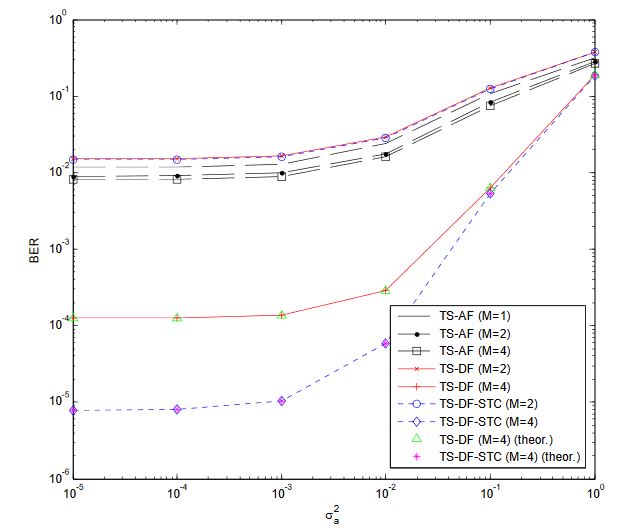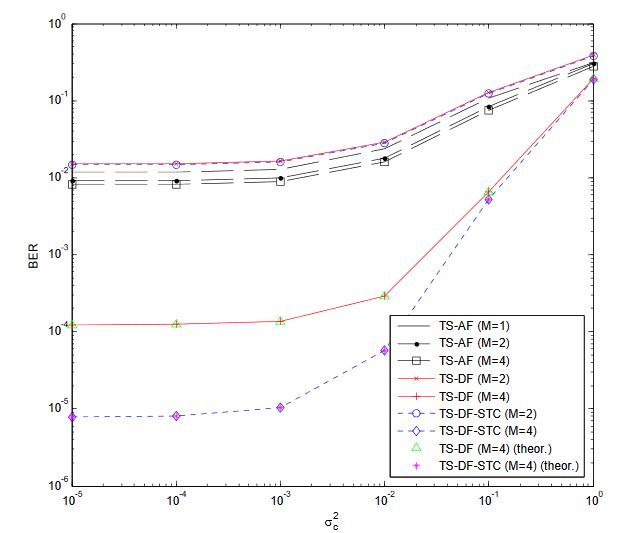ABSTRACT
In this paper, we propose various kinds of two-way multi-antenna relaying with simultaneous wireless information and power transfer (SWIPT) and investigate their performance. Specifically, we first consider a two-way relay network where two single-antenna end nodes communicate with each other through a multi-antenna relay node that is energy constrained. This relay node harvests energy from the two end nodes and use the harvested energy for forwarding their information.
Six relaying schemes that support the considered network then build on the power splitting-based relaying and time switching-based relaying protocols. The average bit error rates of these schemes are evaluated and compared by computer simulations considering several network parameters, including the number of relay antennas, power splitting ratio, and energy harvesting time. Such evaluation and comparison provide useful insights into the performance of SWIPT-based two-way multi-antenna relaying.
SYSTEM MODEL
Consider a two-way relay network as shown in Figure 1, where end nodes T1 and T2, each of which is equipped with one antenna, exchange information through an energy-constrained intermediate relay node, R, possessing M antennas. This relay node will harvest energy from the two end nodes and use the harvested energy for forwarding their information. The relay node’s antennas are spatially spaced in such a way that the received/transmitted signals undergo statistically independent fading.
PSR PROTOCOL

Figure 2. (a) Key parameter in the PSR protocol for energy harvesting and information processing at the relay node
Figure 2 illustrates the key parameters in the PSR protocol for energy harvesting and information processing at the relay node R and the block diagram of the corresponding receiver. In Figure 2a, the first block time N is used for multiple access (MA) where the end nodes T1 and T2 transmit their signals simultaneously, and P is the total signal power.
TSR PROTOCOL

Figure 3. (a) Key parameters in the TSR protocol for energy harvesting and information processing at the relay node
Figure 3 illustrates the key parameters in the TSR protocol for energy harvesting and information processing at the relay node R and the block diagram of the corresponding receiver. In Figure 3a, α is the fraction of the total block time 2 N in which the relay node harvests energy from the end nodes T1 and T2, where 0 ≤ α ≤ 1. The remaining block time 2 (1 − α) N is used for information transmission, such that the first half of that is used for MA and the second half is used for BC.
SIMULATION RESULTS

Figure 6. BER versus antenna noise variance

Figure 7. BER versus conversion noise variance
We can see that the theoretical results perfectly match their simulation counterparts, which verifies the BER formulae derived in Sections 3.1 and 3.2. Similarly, the results for the TS-DF, TS-DF-STC, and TS-AF cases are shown in Figures 6 and 7.
CONCLUSIONS
Based on two SWIPT protocols, namely TSR and PSR, we have presented various two-way multi-antenna relaying schemes, where an energy-constrained relay node harvests energy from two source nodes and uses that harvested energy to forward their information. We have compared the BER performance of these SWIPT-based relaying schemes, and have studied the effect of several network parameters, including the number of relay antennas, power splitting ratio, and energy harvesting time.
The results have revealed that the benefit of multiple-antenna deployment at the relay depends primarily on the number of antennas (e.g., two antennas versus four antennas), the signal-processing technique (e.g., AF versus DF), and the power allocation strategy (e.g., equal power allocation versus optimal power allocation). In addition, despite the fact that the optimal power allocation is preferable to the equal power allocation, the latter seems an attractive choice for the PS-AF and TS-AF schemes. For the other relaying schemes (i.e., PS-DF, PS-DF-STC, TS-DF, and TS-DF-STC), algorithmic determination of the optimal power splitting ratio and optimal energy harvesting time could be an interesting direction for future work.
Source: Rangsit University
Authors: Thanaphat Srivantana | Kiattisak Maichalernnukul
>> Antenna Digital Processing Projects for Students
>> More Wireless Energy Projects for Final Year Students